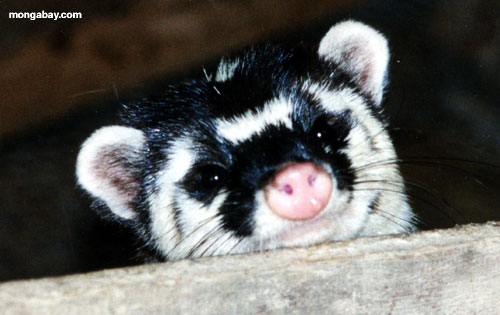 |
|
China to Kill 10,000 Civet Cats in Effort to Eradicate SARS
By KEITH BRADSHER and LAWRENCE K. ALTMAN
Published: January 5, 2004
Reuters
http://www.nytimes.com/2004/01/05/international/asia/05SARS.html

Civit in Cambodia
|
HONG KONG, Monday, Jan. 5 — Officials in Guangdong Province in southeastern China ordered this morning the immediate killing of every civet cat in captivity in the province after researchers found that a Guangdong man had fallen ill with a new strain of SARS virus that is genetically similar to a strain found in civet cats.
Dr. Zhong Nanshan, China's top expert on SARS, said that senior provincial health, agriculture and forestry officials were holding an emergency meeting this morning to discuss how to carry out the decision as quickly as possible. All civet cats — relatives of the mongoose widely eaten in winter as a delicacy — will be killed "in a few days," Dr. Zhong said.
On Monday, the case in Guangdong was confirmed by the World Health Organization.
A Guangdong provincial official said that about 10,000 civet cats would be killed. Dr. Zhong said that there would also be an effort to trap and kill civet cats in the wild, but the Guangdong provincial official said that at least initially, the government would only try to kill civet cats at restaurants, on farms and in wild-animal markets.
Dr. Zhong joined Hong Kong University microbiologists at a news conference here this morning to announce that they had jointly completed a detailed study of SARS-like viruses in civet cats together with a genetic analysis of viral samples taken from a 32-year-old man in Guangzhou who is suspected of having SARS.
Initial research last spring had shown that the SARS virus that infected more than 8,000 people around the world was genetically very similar to a virus in civet cats. New research this winter shows that the virus in civet cats has mutated to form a new "sublineage" of the virus, said Dr. K.Y. Yuen, the head of the microbiology department at Hong Kong University.
Dr. Yuen said that a genetic sequencing of samples from the man in Guangzhou who has SARS had found that the main "spike" protein was exactly identical, down to the last amino acid, to the new sublineage of the virus found in civet cats. Dr. Guan Yi, another Hong Kong University microbiologist, said that it was too soon to say whether the new sublineage was any more or less infectious or lethal in people than the SARS virus that spread last spring.
The researchers said that it remained unclear how the sick man had contracted the virus, especially since the man has insisted that he did not have any contact with exotic animals in the month before he became feverish on Dec. 16. Dr. Zhong warned that with the beginning of the dry season here in southeastern China, civet cat feces could dry up and become windblown dust that would raise a risk of airborne infection.
The feces carry extremely high concentrations of the virus, which can still be detected even when the feces are diluted as much as one billion times, Dr. Zhong said. Since it took a month from the first hospital case of SARS — in mid-December 2002 — until a major outbreak started in mid-January in the Guangzhou area, doctors in Guangdong and Hong Kong should be alert for more cases, he warned.
Guangzhou is 80 miles up the Pearl River from Hong Kong and is the capital of Guangdong Province, which has 79 million people.
Reuters reported on Monday that health officials in the Philippines had isolated a woman suspected of having contracted SARS while working in Hong Kong. Further tests were needed, the officials cautioned, but the woman's doctor was also isolated as a precaution. Reuters also reported that the woman's husband had been isolated. The news agency said the woman, 41, was being treated for pneumonia and that her husband had a fever.
Public health experts have warned that if the virus causing SARS, or severe acute respiratory syndrome, can survive in wild animals, it would be harder to eradicate and could periodically infect people again.
Hong Kong severely restricts the sale of wild animals as food. Mainland China imposed restrictions last spring in response to preliminary research suggesting that SARS came from wild animals, but allowed sales to resume last autumn after complaints by people who farm civet cats and other exotic species.
Roy Wadia, a spokesman for the World Health Organization, said that samples from the sick man in Guangzhou were being tested at two Hong Kong labs, one at Hong Kong University and the other at Chinese University, and at a lab in Beijing.
Health officials are monitoring 81 of the man's contacts, who are all well, Dr. Julie L. Hall, an expert at the World Health Organization said in a telephone interview. "That is quite a complex and difficult investigation to do," Dr. Hall said.
To reduce the chance that the infection might spread, health officials were also being asked to seek any additional people with whom the man may have come in contact.
Dr. Hall said that health workers were testing a variety of animals as a possible source of his infection.
She said that research into how animals transmit SARS to people could be as important as which animals have it. If the transmission can be understood, better regulations could be designed for the slaughter or other handling of species prone to infection, she said.
Keith Bradsher reported from Hong Kong for this article and Lawrence K. Altman from Washington.
Also see:
China Lifts Wild Animal Ban -- "Bushmeat" returns to the Market
Masked Palm Civet
New SARS-like Mystery disease in Cambodia
Nipah virus, bats, and forest loss in Malaysia
CONTENT COPYRIGHT REUTERS. THIS CONTENT IS INTENDED SOLELY FOR EDUCATIONAL PURPOSES.
|
 A Place Out of Time:
A Place Out of Time:
Tropical Rainforests - Their Wonders and the Perils They Face. Information on rainforests, biodiversity, and environmental concerns.
|
|